Top Rankings
Fort Payne City School District ranks among the top 20% of public school district in Alabama for:
Category
Attribute
Graduation Rate
Highest graduation rate (Top 5%)
For the 2025 school year, there is 1 public middle school serving 756 students in Fort Payne City School District. This district's average middle testing ranking is 9/10, which is in the top 20% of public middle schools in Alabama.
ÎÛÎÛÂþ» Middle School in Fort Payne City School District have an average math proficiency score of 30% (versus the Alabama public middle school average of 21%), and reading proficiency score of 55% (versus the 46% statewide average).
Minority enrollment is 52% of the student body (majority Hispanic), which is more than the Alabama public middle school average of 45% (majority Black).
Overview
This School District
This State (AL)
# Schools
5 Schools
534 Schools
# Students
3,550 Students
236,737 Students
# Teachers
213 Teachers
12,843 Teachers
Student : Teacher Ratio
17:1
17:1
District Rank
Fort Payne City School District, which is ranked within the top 30% of all 145 school districts in Alabama (based off of combined math and reading proficiency testing data) for the 2021-2022 school year.
The school district's graduation rate of 96% has decreased from 97% over five school years.
Overall District Rank
#41 out of 145 school districts
(Top 30%)
(Top 30%)
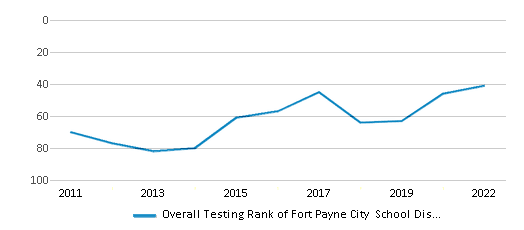
Math Test Scores (% Proficient)
34%
29%
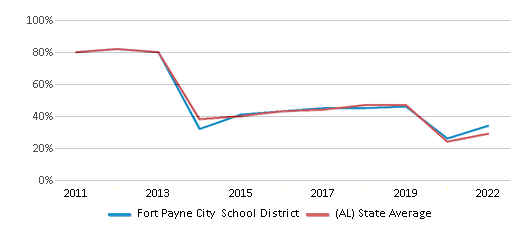
Reading/Language Arts Test Scores (% Proficient)
50%
47%
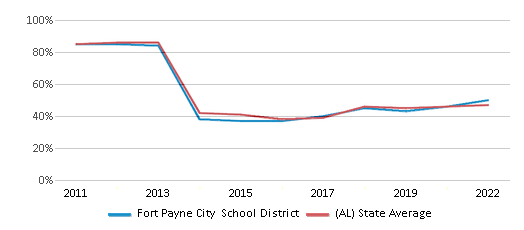
Science Test Scores (% Proficient)
33%
38%
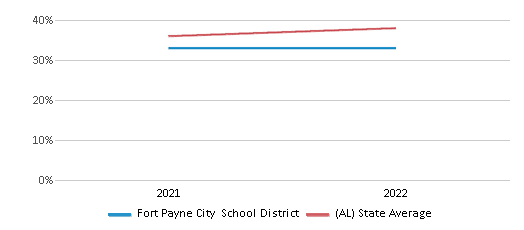
Graduation Rate
96%
88%
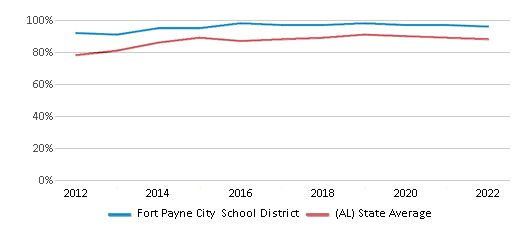
Students by Ethnicity:
Diversity Score
0.57
0.61
# American Indian Students
36 Students
3,329 Students
% American Indian Students
1%
2%
# Asian Students
25 Students
2,720 Students
% Asian Students
1%
1%
# Hispanic Students
1,517 Students
24,370 Students
% Hispanic Students
43%
10%
# Black Students
109 Students
68,686 Students
% Black Students
3%
29%
# White Students
1,771 Students
129,762 Students
% White Students
50%
55%
# Hawaiian Students
2 Students
257 Students
% Hawaiian Students
n/a
n/a
# Two or more races Students
90 Students
7,613 Students
% of Two or more races Students
2%
3%
Students by Grade:
# Students in PK Grade:
153
2,540
# Students in K Grade:
229
5,092
# Students in 1st Grade:
263
5,246
# Students in 2nd Grade:
282
5,239
# Students in 3rd Grade:
261
5,011
# Students in 4th Grade:
254
5,480
# Students in 5th Grade:
240
10,423
# Students in 6th Grade:
240
39,140
# Students in 7th Grade:
249
55,757
# Students in 8th Grade:
267
56,367
# Students in 9th Grade:
287
13,737
# Students in 10th Grade:
263
11,591
# Students in 11th Grade:
293
10,975
# Students in 12th Grade:
269
10,139
# Ungraded Students:
-
-
District Revenue and Spending
The revenue/student of $11,861 in this school district is less than the state median of $13,006. The school district revenue/student has stayed relatively flat over four school years.
The school district's spending/student of $11,253 is less than the state median of $12,220. The school district spending/student has stayed relatively flat over four school years.
Total Revenue
$42 MM
$9,671 MM

Spending
$40 MM
$9,086 MM

Revenue / Student
$11,861
$13,006

Spending / Student
$11,253
$12,220
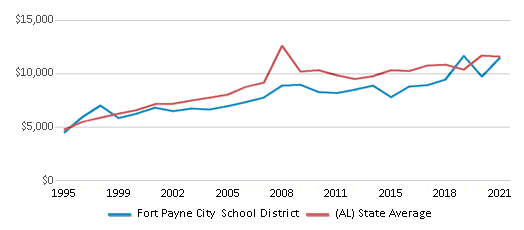
Best Fort Payne City School District ÎÛÎÛÂþ» Middle Schools (2025)
School
(Math and Reading Proficiency)
(Math and Reading Proficiency)
Location
Grades
Students
Rank: #11.
Fort Payne Middle School
(Math: 30% | Reading: 55%)
Rank:
Rank:
7/
Top 50%10
4910 Martin Ave Ne
Fort Payne, AL 35967
(256) 845-7501
Fort Payne, AL 35967
(256) 845-7501
Grades: 6-8
| 756 students
Recent Articles

Year-Round Or Traditional Schedule?
Which is more appropriate for your child? A year-round attendance schedule or traditional schedule? We look at the pros and cons.

Why You Should Encourage Your Child to Join a Sports Team
Participating in team sports has a great many benefits for children, there is no doubt. In this article you will learn what those benefits are.

White Students are Now the Minority in U.S. ÎÛÎÛÂþ» Schools
Increasing birth rates among immigrant families from Asia and Central and South America, combined with lower birth rates among white families, means that for the first time in history, public school students in the United States are majority-minority. This shift in demographics poses difficulties for schools as they work to accommodate children of varying language abilities and socio-economic backgrounds.





